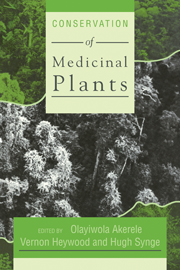Book contents
- Frontmatter
- Contents
- Contributors
- Preface
- Acknowledgements
- The Chiang Mai Declaration
- Introduction
- The Issue of Medicinal Plants
- Science, Industry and Medicinal Plants
- Techniques to Conserve Medicinal Plants
- Policies to Conserve Medicinal Plants
- Experiences from Programmes to Conserve Medicinal Plants
- 21 Medicinal Plants in India: Approaches to Exploitation and Conservation
- 22 The Chinese Approach to Medicinal Plants – Their Utilization and Conservation
- 23 Conservation of Medicinal Plants in Kenya
- 24 Complexity and Conservation of Medicinal Plants: Anthropological Cases from Peru and Indonesia
- 25 Utilization of Indigenous Medicinal Plants and their Conservation in Bangladesh
- 26 Development of a Conservation Policy on Commercially Exploited Medicinal Plants: A Case Study from Southern Africa
22 - The Chinese Approach to Medicinal Plants – Their Utilization and Conservation
Published online by Cambridge University Press: 07 September 2010
- Frontmatter
- Contents
- Contributors
- Preface
- Acknowledgements
- The Chiang Mai Declaration
- Introduction
- The Issue of Medicinal Plants
- Science, Industry and Medicinal Plants
- Techniques to Conserve Medicinal Plants
- Policies to Conserve Medicinal Plants
- Experiences from Programmes to Conserve Medicinal Plants
- 21 Medicinal Plants in India: Approaches to Exploitation and Conservation
- 22 The Chinese Approach to Medicinal Plants – Their Utilization and Conservation
- 23 Conservation of Medicinal Plants in Kenya
- 24 Complexity and Conservation of Medicinal Plants: Anthropological Cases from Peru and Indonesia
- 25 Utilization of Indigenous Medicinal Plants and their Conservation in Bangladesh
- 26 Development of a Conservation Policy on Commercially Exploited Medicinal Plants: A Case Study from Southern Africa
Summary
The Present Situation
In China, medicinal plants enjoy an inherent and prominent role in the general health service and are by no means secondary in functions to synthetic drugs and antibiotics. This fact is well reflected by the Chinese Pharmacopoeia (in 2 volumes, 1985 ed.), of which the first volume is totally devoted to traditional Chinese crude drugs (consisting nearly exclusively of medicinal plants) and their varied preparations, with a total of 713 items, including 385 items of crude drugs (excluding their preparations), of medicinal plant origin (Yang, 1985, Xiao, 1989); the second volume lists all the chemical, antibiotic and biological drugs along with their preparations, totalling 776 items (Yuan & Zhang, 1985). The importance of medicinal plants is also evidenced from the statistic that the market for traditional Chinese drugs accounted for an average to 40% of the total consumption of medicaments in recent years (Xiao, 1983).
Unfortunately, due to the destruction of forests, overgrazing of meadows, expansion of industry and urbanization, as well as excessive collection in the wild of rare and endangered plants, the natural resources of medicinal plants are being reduced day by day. There has, therefore, been an urgent need to draw up the necessary plans for medicinal plant utilization and conservation by our State Government.
The Strategies Adopted
Investigation and Systematization
As the first stage of a long-term programme on the utilization and conservation of Chinese medicinal plants, a nation-wide survey project on this subject, involving several years of hard work, has been conducted, with the items recorded including their origin, distribution, ecological features, resources and their therapeutic effectiveness.
- Type
- Chapter
- Information
- Conservation of Medicinal Plants , pp. 305 - 314Publisher: Cambridge University PressPrint publication year: 1991
- 3
- Cited by



